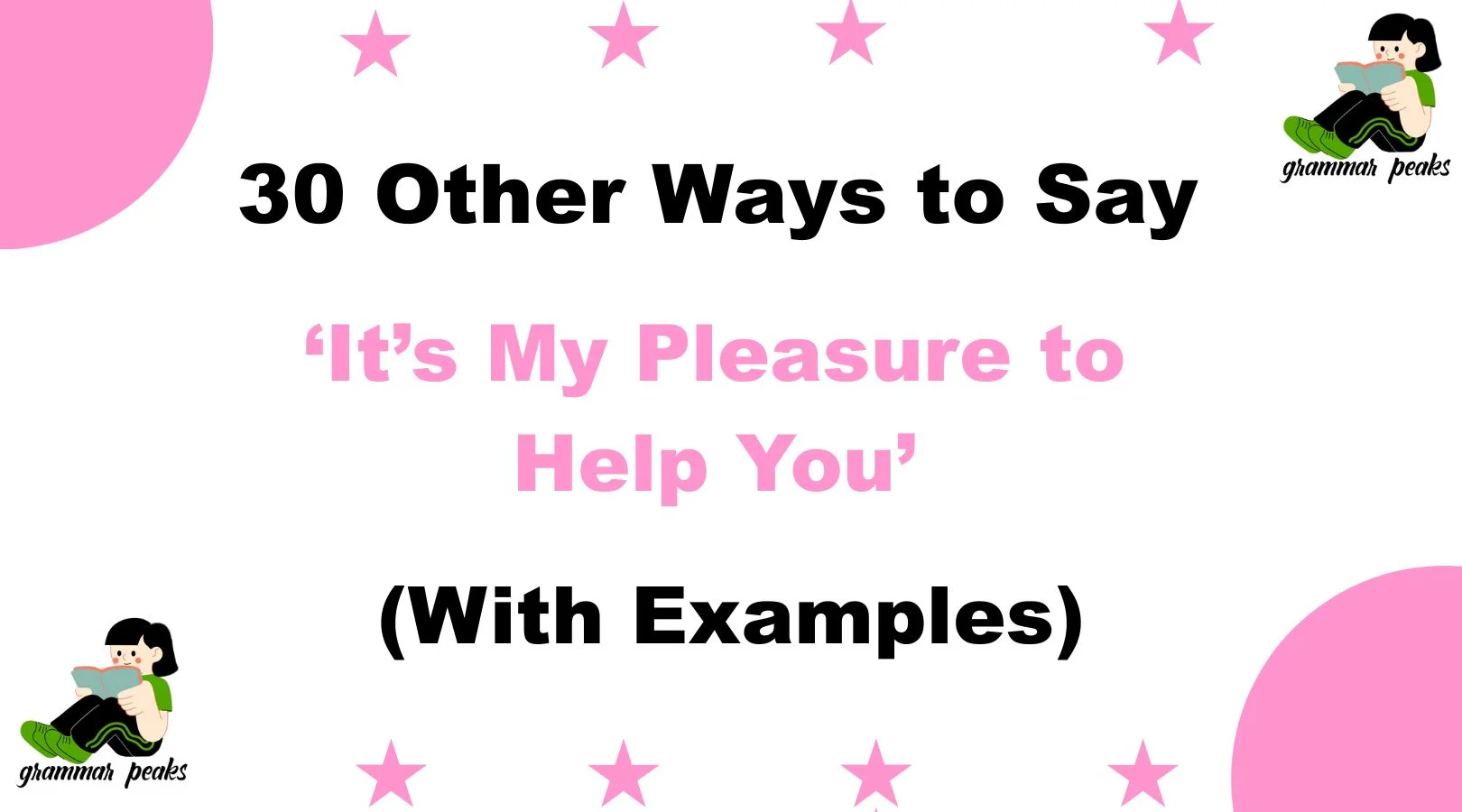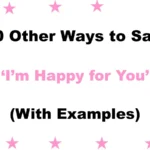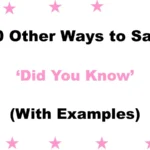Expressing gratitude and warmth in our responses can make a world of difference in how others feel. Saying “It’s my pleasure to help you” is a kind way to show willingness and care, but sometimes, using different phrases can make your message even more personal, thoughtful, and engaging. Whether in professional settings or casual conversations, choosing the right words can brighten someone’s day and strengthen connections.
This article offers 30 empathetic alternatives to help you express yourself with genuine warmth and kindness — all while sounding natural and sincere. Let’s explore these options, understand when to use them, and how they can enhance your communication.
What Does “It’s My Pleasure to Help You” Mean?
The phrase “It’s my pleasure to help you” means that you are happy and willing to assist someone. It expresses genuine kindness and readiness to provide support without reluctance. Saying this shows you value the opportunity to help and want the other person to feel appreciated.
When to Use “It’s My Pleasure to Help You”
Use this phrase when you want to offer assistance warmly and politely, especially in customer service, teamwork, or everyday favors. It works best when you want to express gratitude for being able to help, making the interaction feel respectful and considerate.
Is It Professional/Polite to Say “It’s My Pleasure to Help You”?
Yes, it is both professional and polite. The phrase strikes a balance between formal courtesy and friendly warmth, making it appropriate for business communications, emails, meetings, and casual conversations.
Pros and Cons of Saying “It’s My Pleasure to Help You”
Pros:
- Shows enthusiasm and kindness
- Builds rapport and trust
- Encourages positive interactions
Cons:
- Can sound repetitive if overused
- Might feel overly formal in very casual settings
Synonyms for “It’s My Pleasure to Help You”
- I’m happy to assist you
- Glad to be of service
- I’m here to help
- Always happy to help
- It’s an honor to support you
- I’m delighted to assist
- At your service
- I’m glad to help out
- It’s a joy to help
- Happy to lend a hand
- It’s my joy to assist you
- I’m pleased to be of help
- I’m always ready to assist
- It’s my delight to support you
- I’m at your disposal
- Always ready to help
- I’m glad to be of assistance
- It’s my privilege to help
- I’m eager to help
- I’m thankful to assist you
- I’m pleased to help
- It’s my satisfaction to help
- I’m always happy to support
- Ready and willing to help
- It’s my happiness to assist
- I’m joyful to help you
- I’m here to support you
- It’s a pleasure assisting you
- Glad to provide support
- I’m happy to serve you
1. I’m Happy to Assist You
Definition: Expresses readiness and happiness to provide help.
Explanation: This phrase conveys a warm willingness, showing that you are approachable and positive about offering help.
Example: “If you have any questions, I’m happy to assist you.”
Best Use: Professional and casual situations where you want to sound friendly and helpful.
Worst Use: Avoid overly formal documents, where more formal language may be expected.
Tone: Warm, approachable, and polite.
2. Glad to Be of Service
Definition: Shows pleasure in being useful or helpful.
Explanation: This phrase is respectful and professional, often used in customer service or formal contexts.
Example: “Thank you for reaching out — I’m glad to be of service.”
Best Use: Formal and semi-formal settings.
Worst Use: Can sound stiff in casual conversations.
Tone: Professional and courteous.
3. I’m Here to Help
Definition: Indicates availability and readiness to assist.
Explanation: Simple and straightforward, it reassures someone that help is available whenever needed.
Example: “Don’t hesitate to ask — I’m here to help.”
Best Use: Customer service, team settings, informal and formal.
Worst Use: May sound generic if repeated often.
Tone: Friendly and supportive.
4. Always Happy to Help
Definition: Expresses ongoing willingness and positivity about assisting.
Explanation: Shows that helping is not just a one-time thing but a continual commitment.
Example: “If you need anything else, I’m always happy to help.”
Best Use: Casual and professional contexts where warmth is important.
Worst Use: Might seem informal for very strict business environments.
Tone: Warm, dependable, and friendly.
5. It’s an Honor to Support You
Definition: Highlights respect and gratitude in offering help.
Explanation: Elevates the act of helping to something meaningful and valued.
Example: “Thank you for trusting me — it’s an honor to support you.”
Best Use: Formal or meaningful interactions, showing deep appreciation.
Worst Use: Could be too heavy for light or casual exchanges.
Tone: Respectful, sincere, and heartfelt.
6. I’m Delighted to Assist
Definition: Shows joy and enthusiasm in providing help.
Explanation: Adds a cheerful tone to your willingness to assist.
Example: “I’m delighted to assist you with your request.”
Best Use: Semi-formal communications where warmth is desired.
Worst Use: Might sound too enthusiastic in very formal or serious contexts.
Tone: Cheerful and polite.
7. At Your Service
Definition: A classic phrase meaning ready and willing to help.
Explanation: Often used to indicate full availability and commitment to assist.
Example: “Please let me know if you need anything — I’m at your service.”
Best Use: Formal, customer service, or polite casual exchanges.
Worst Use: Can sound old-fashioned or overly formal if misused.
Tone: Respectful and courteous.
8. I’m Glad to Help Out
Definition: Expresses happiness in providing support or help.
Explanation: Casual and friendly, great for informal settings.
Example: “I’m glad to help out with your project.”
Best Use: Informal teamwork or friend interactions.
Worst Use: Not ideal for formal or corporate emails.
Tone: Casual and warm.
9. It’s a Joy to Help
Definition: Emphasizes happiness and delight in helping others.
Explanation: Conveys heartfelt pleasure in being useful.
Example: “It’s a joy to help you find the best solution.”
Best Use: Warm, personal interactions.
Worst Use: May be too informal or emotional for business.
Tone: Heartfelt and enthusiastic.
10. Happy to Lend a Hand
Definition: Willing to help with tasks or problems.
Explanation: Casual and friendly phrases often used among peers.
Example: “If you need support, I’m happy to lend a hand.”
Best Use: Informal work or social situations.
Worst Use: Avoid formal professional communication.
Tone: Friendly and approachable.
11. It’s My Joy to Assist You
Definition: Expresses a deep personal happiness in helping someone.
Explanation: This phrase conveys that helping is not just a duty but a genuine source of joy for you.
Example: “It’s my joy to assist you with your inquiry.”
Best Use: Personal or semi-formal conversations where warmth is key.
Worst Use: Avoid in highly formal or strictly professional documents.
Tone: Warm, heartfelt, and sincere.
12. I’m Pleased to Be of Help
Definition: A polite way to say you are happy to assist.
Explanation: It sounds professional and courteous, expressing satisfaction in providing help.
Example: “I’m pleased to be of help during this process.”
Best Use: Professional emails, customer service, or formal chats.
Worst Use: Might feel too formal in casual conversations.
Tone: Polite and professional.
13. I’m Always Ready to Assist
Definition: Expresses consistent willingness to offer help anytime.
Explanation: Implies reliability and ongoing availability.
Example: “If you need anything else, I’m always ready to assist.”
Best Use: Formal or informal contexts emphasizing dependability.
Worst Use: Could sound repetitive if overused.
Tone: Dependable and courteous.
14. It’s My Delight to Support You
Definition: Shows pleasure and happiness in offering support.
Explanation: Highlights a joyful approach to helping someone.
Example: “It’s my delight to support you through this.”
Best Use: Warm, semi-formal interactions.
Worst Use: May seem too emotional in very formal settings.
Tone: Cheerful and caring.
15. I’m at Your Disposal
Definition: Indicates you are fully available to help as needed.
Explanation: A formal phrase suggesting readiness to serve.
Example: “I’m at your disposal for any assistance you require.”
Best Use: Formal business or customer service communications.
Worst Use: Could feel too formal or distant in casual talk.
Tone: Formal and respectful.
16. Always Ready to Help
Definition: Shows continuous willingness to assist whenever needed.
Explanation: Emphasizes ongoing availability and helpfulness.
Example: “I’m always ready to help with your questions.”
Best Use: Both formal and informal settings where friendliness is valued.
Worst Use: Avoid sounding generic or mechanical if repeated.
Tone: Friendly and supportive.
17. I’m Glad to Be of Assistance
Definition: A courteous way to express happiness in helping.
Explanation: Professional and polite, suitable for many situations.
Example: “I’m glad to be of assistance with your concerns.”
Best Use: Professional emails, meetings, or customer support.
Worst Use: Might sound stiff if overused in casual talks.
Tone: Polite and professional.
18. It’s My Privilege to Help
Definition: Shows honor and respect in offering help.
Explanation: Elevates the act of helping as a special opportunity.
Example: “It’s my privilege to help you with this matter.”
Best Use: Formal or meaningful contexts.
Worst Use: Too formal for everyday casual conversations.
Tone: Respectful and sincere.
19. I’m Eager to Help
Definition: Expresses enthusiasm and readiness to assist.
Explanation: Highlights your excitement and willingness to support.
Example: “I’m eager to help you solve this issue.”
Best Use: Friendly and motivational communications.
Worst Use: Could sound pushy in overly formal contexts.
Tone: Energetic and warm.
20. I’m Thankful to Assist You
Definition: Expresses gratitude for the chance to help.
Explanation: Combines thankfulness and willingness in one phrase.
Example: “I’m thankful to assist you with your request.”
Best Use: Personal or semi-formal communications showing appreciation.
Worst Use: Might sound unusual or overly formal in casual talks.
Tone: Grateful and sincere.
21. I’m Pleased to Help
Definition: A polite and positive way to say you are happy to assist.
Explanation: Shows satisfaction and readiness to support.
Example: “I’m pleased to help with any concerns you have.”
Best Use: Professional or casual situations where politeness is important.
Worst Use: Could sound generic if repeated too often.
Tone: Polite and friendly.
22. It’s My Satisfaction to Help
Definition: Indicates personal fulfillment in providing assistance.
Explanation: Shows that helping brings you contentment.
Example: “It’s my satisfaction to help you complete this task.”
Best Use: Warm, semi-formal settings.
Worst Use: May sound awkward or unusual in casual talk.
Tone: Sincere and thoughtful.
23. I’m Always Happy to Support
Definition: Expresses ongoing happiness to offer help or encouragement.
Explanation: Indicates that you consistently enjoy assisting others.
Example: “I’m always happy to support your efforts.”
Best Use: Friendly or professional contexts emphasizing support.
Worst Use: Avoid sounding repetitive.
Tone: Warm and supportive.
24. Ready and Willing to Help
Definition: Shows readiness combined with enthusiasm to assist.
Explanation: Emphasizes active willingness to provide support.
Example: “I’m ready and willing to help whenever needed.”
Best Use: Both casual and professional situations.
Worst Use: Can feel overly formal if repeated often.
Tone: Courteous and eager.
25. It’s My Happiness to Assist
Definition: Expresses that helping others makes you happy.
Explanation: Personalizes your willingness with genuine joy.
Example: “It’s my happiness to assist you with your needs.”
Best Use: Warm, personal conversations or emails.
Worst Use: Too emotional for very formal environments.
Tone: Heartfelt and cheerful.
26. I’m Joyful to Help You
Definition: Conveys a cheerful and positive attitude toward helping.
Explanation: Highlights happiness and optimism in support.
Example: “I’m happy to help you with your project.”
Best Use: Informal and friendly communications.
Worst Use: Not suitable for formal or strict professional settings.
Tone: Cheerful and sincere.
27. I’m Here to Support You
Definition: Indicates availability and willingness to back someone up.
Explanation: Shows commitment to providing help and encouragement.
Example: “Remember, I’m here to support you whenever you need.”
Best Use: Both personal and professional contexts.
Worst Use: Could sound vague if overused.
Tone: Supportive and reassuring.
28. It’s a Pleasure Assisting You
Definition: Polite way to express enjoyment in helping.
Explanation: Combines professionalism with warmth.
Example: “It’s a pleasure assisting you with your questions.”
Best Use: Formal or semi-formal communication.
Worst Use: Avoid in very casual settings where it may sound stiff.
Tone: Polite and courteous.
29. Glad to Provide Support
Definition: Expresses willingness and happiness to help.
Explanation: Suitable for both emotional and practical assistance.
Example: “I’m glad to provide support during this time.”
Best Use: Both personal and professional situations.
Worst Use: May sound generic if repeated too often.
Tone: Warm and approachable.
30. I’m Happy to Serve You
Definition: Indicates readiness and joy in helping.
Explanation: A respectful and somewhat formal phrase.
Example: “I’m happy to serve you with any needs you have.”
Best Use: Formal customer service or professional contexts.
Worst Use: Can sound old-fashioned or overly formal in casual talk.
Tone: Respectful and professional.
Conclusion
Finding the right words to say “It’s my pleasure to help you” can elevate your communication by adding warmth, sincerity, and professionalism. Each alternative phrase carries its own nuance and is suited for different situations, tones, and audiences.
Whether you want to sound friendly and casual, respectful and formal, or enthusiastic and supportive, this list provides a variety of options that help you connect meaningfully with others. Remember, expressing care thoughtfully not only makes your message more effective but also strengthens relationships by showing genuine appreciation and kindness.
FAQs
1. What does “It’s my pleasure to help you” really mean?
This phrase means that you are happy and willing to assist someone. It expresses genuine kindness and warmth, showing that helping isn’t just a task but something you enjoy doing. It helps create a positive and caring tone in conversations.
2. When is the best time to say “It’s my pleasure to help you”?
It’s best to say this phrase after someone has thanked you for your assistance. It works well in customer service, professional settings, or personal conversations to communicate that you are happy to offer help whenever needed.
3. Are there more formal or casual alternatives to “It’s my pleasure to help you”?
Yes! There are many alternatives that vary in tone. For example, “I’m at your disposal” is more formal, while “Glad to provide support” is more casual. Choosing the right phrase depends on your audience and the situation.
4. How can I sound more empathetic when offering help?
Use phrases that convey warmth and genuine care, like “It’s my joy to assist you” or “I’m here to support you.” Adding personal touches or enthusiasm helps the other person feel truly valued and understood.
5. Can saying “It’s my pleasure to help you” improve my professional relationships?
Absolutely. Using this phrase or its alternatives shows politeness, respect, and willingness, which helps build trust and rapport. Thoughtful communication fosters better collaboration and positive impressions in the workplace.

Mariah Cannon is a dedicated Senior Content Specialist at GrammarPeaks, known for her clear, engaging writing and deep knowledge of English grammar and usage. With a background in linguistics and years of experience in content development, Mariah crafts informative and accessible articles that empower readers to master the nuances of the English language. Her work reflects a commitment to clarity, education, and helping others express themselves with confidence.





